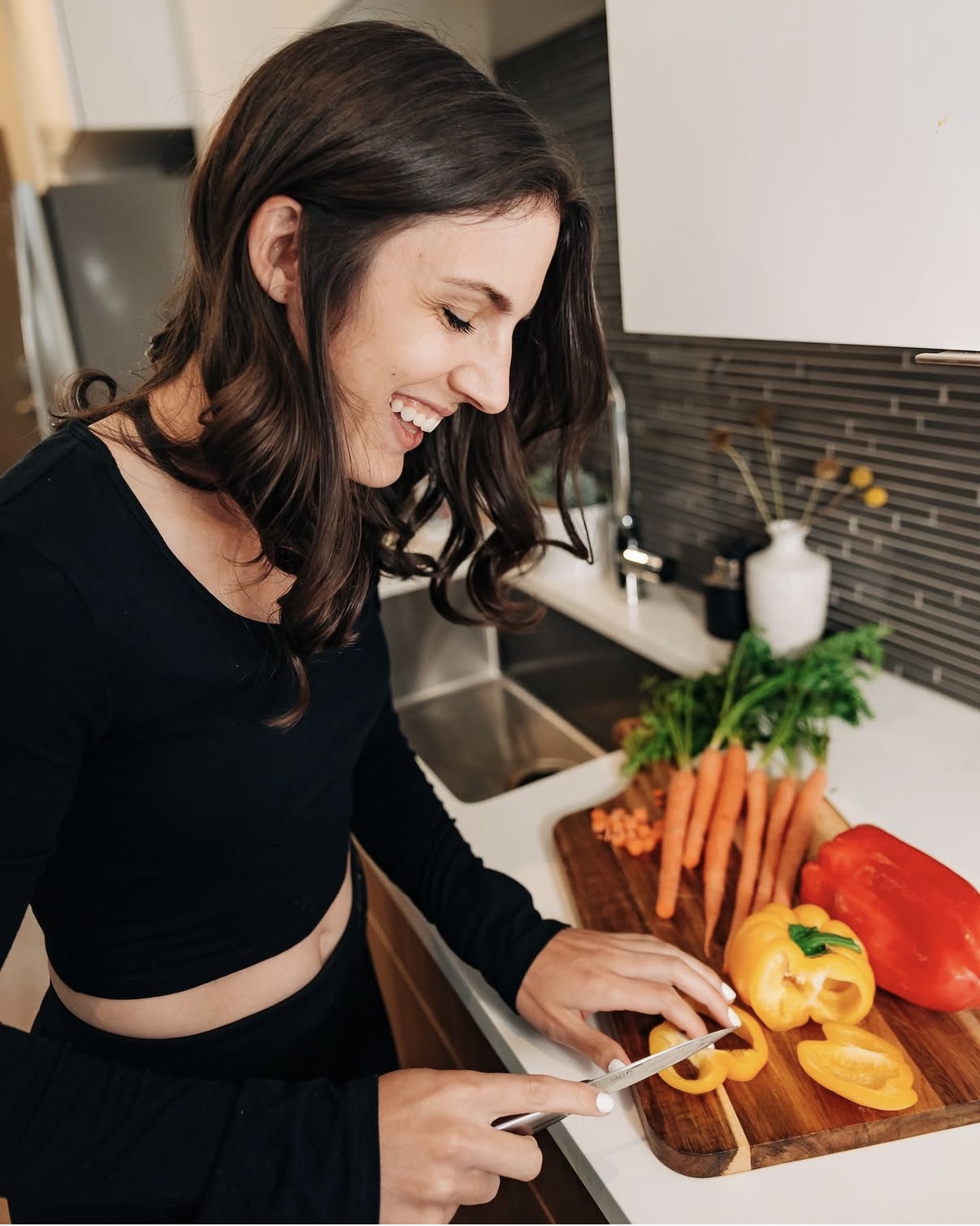
Nutrition
Have you found yourself frequently relying on DoorDash or skipping lunches? I get it. It’s tough finding time to meal prep when you are busy caring for your family, building a career, and maintaining and developing friendships, all while trying to improve your fitness, sleep enough, manage stress, and eat the proper quality and quantity of food to support your life and activities. With that said, it’s not impossible to achieve if you have a plan. So how can you simplify it and create a repeatable system so you can spend less time whipping up grub in the kitchen and more time with the people you love and doing the things you enjoy?
Meal prepping does not need to be complicated. In fact, when you break it down, it’s quite straight forward and more accessible than you think. And, no, I’m not going to tell you to just eat chicken, rice, and broccoli for all of your meals. Let’s get into how you can benefit, what a well-rounded meal prep looks like, and how to build a plan and simplify the process.
Do you have goals of gaining strength and improving endurance alongside your busy lifestyle? Learn more about my program, Sustainably Fit, and why it was meant for you.
Meal prepping is one of many ways that you can stick to your wellness goals and create consistency within your fitness routine. Clients who have worked with me generally have better outcomes when they address more than just their workout routine. By planning at least one component of their meal prep or approach to food (be it breakfast, lunch, dinner, or snacks), they are more likely to stick to their training program. This in turn allows them to achieve the results they seek, such as gaining strength, building muscle, improving endurance, or enhancing performance. But, the benefits go beyond the basics of fitness.
Meal prepping can…
- Support your financial goals. By planning ahead, you can stick to your allocated food budget for the week instead of catching yourself slipping with extra restaurant outings or multiple grocery runs in a week. Regardless if your weekly food budget is $100 or $500, you can plan your meals accordingly to increase both your longevity AND net worth. A win-win!
- Offer healthier options. When you go to a restaurant or order takeout, you might have a general idea of total calories based on the restaurants’ suggestion, but if we’re being honest here, those calories are guesstimates. Unless every item is weighed (unlikely), the calories will vary plate to plate. Aside from calories, it’s also unlikely that you know what ingredients were put in. While I’m not here to fear monger (I’m certainly not against any specific ingredient nor think that a long list of ingredients you cannot pronounce is inherently bad), it’s hard to know what all was put in there and what’s adding calories. For example, if you go to a steakhouse, you might think, “oh perfect, this steak is a great protein source”. While this is true, steak is higher in protein, it likely also has lots of butter added because butter makes things taste phenomenal. So what you think might have +/-20g of fat, actually has significantly more since you weren’t there watching it be cooked in yummy garlic herb butter. Again, this does not mean butter is bad or fat is bad, but if you were meal prepping at home, you may not consume as much as you would at a restaurant. Meal prepping at home allows you to ensure you are eating nutritious, well-balanced meals that include high protein, fiber, carbs, and fats.
- Reduce food waste. With large portions served at restaurants, it’s common to throw away part of the meal. Whether it’s extra sides, sauces, or dressings, often at least some part of the meal out is unfortunately getting tossed. By cooking at home with what you already have or what you purposefully purchased at the grocery store, you can reduce the amount of food you waste. You can create your own portions and add the amount of sauce or dressing you like.
- Save time and avoid decision fatigue. Initially you might be thinking, “how does cooking actually save me time?”. This is a valid question. If you think about the bigger picture: have you considered how much time you and your significant other or family go back and forth about “what do you want to eat?”, “I don’t know, what do you want to eat?” and repeat at least four times? On top of that, by having meals already made in one or two sessions, all you have to do is reheat the meal when it comes lunchtime or dinnertime instead of having to cook a meal from scratch, taking up an extra hour, give or take, everyday.
These are just a few benefits you could reap by planning ahead and taking action.

When it comes to meal prepping, you will want to build meals that are simple and effective at keeping you full and satiated. This likely won’t come from grabbing random items in your pantry.
Building a well-balanced meal means it includes: protein, fiber, carbohydrates, and fats. Having a meal with all four components will leave you feeling satisfied and fuller for longer. Using this formula isn’t just for meal prepping, this is really one that you will want to use for all meals throughout the day to avoid feeling sluggish or underfueled.
The following are general recommendations for those who want to gain strength, build muscle, improve endurance, or enhance performance. For more specific recommendations, I suggest working with a registered dietitian.
For protein, you will want to aim for 1.4-2.0g/kg of body weight of protein per day. For a 150 lb person, that range would be 95-136g of protein per day. For a 225 lb person, that range would be 143-204g of protein per day. This can be achieved by consuming 30-40g of protein at each meal.
For carbohydrates, this recommendation will range widely based on your goals, activity levels, and overall caloric intake. Although carbs are not essential to the body, it is your body’s preferred source of energy. Your body can use carbs and fats as energy, and protein as a last resort if it absolutely needs to. This is why you see quick, simple carbs as suggestions for fuel during your workout, as found in my free guide, Fueling for the Trails. During other meals throughout the day, you will want to primarily consume complex carbohydrates that contain fiber and other nutrients, such as whole grains, legumes, potatoes, fruit, vegetables, etc.
For fats, you will want to consume enough healthy fats to support hormone regulation, manage inflammation, and support brain health and cellular health. On the other hand, the typical American diet is higher fat, so this may not be a macronutrient that will be hard to consume, but it is an area that may need a slight shift to healthier fats. Consider incorporating olive oil, fish, nuts and seeds, dairy products, eggs, and avocado as your main sources of fat to increase or manage healthy fat consumption.
Applying these tactics to each of your meals, especially the ones you meal prep, will allow you to approach your diet in a well-rounded, sustainable way.

What’s meal prep without a plan? Well, just more organized chaos. Now that you understand the benefits of meal prepping and what a balanced diet looks like, let’s get into how to build your meal prep plan.
Be realistic and honest with yourself on how you can approach your meal prep. For example, not everyone wants to nor needs to meal prep for 7 days per week, breakfast, lunch, and dinner. If that suits you, great, but for most people, that is a recipe for burn out. Most people could benefit from meal prepping lunches for 3-4 days per work week and meal planning dinners for 4-5 days per week is plenty sufficient. Notice the difference in meal prepping and meal planning. You want to save room for meals out with friends, colleagues, and family, or when you would rather rely on DoorDash. No, DoorDash is not the enemy, but you’re definitely not going to skip lunch. The goal might not be to completely change your eating lifestyle in a single week, but it should enhance what you are already doing.
Depending on how many days per week you are meal prepping for, you may want to choose more than one day per week to prep. This could be a Sunday and Wednesday or Saturday and Tuesday. Regardless of days chosen, the goal is to give yourself options and variety instead of eating the same lunch 4-5 days in a row.
A big part of why you might not be motivated to meal prep is the actual prep part – cutting veggies, cooking meats, slicing fruit, preparing rice/carbs, etc. These tasks can seem daunting as they can often take the longest. This part of the meal prep is an area where you can cut down on time by purchasing: pre-cut fruits, pre-chopped vegetables, pre-cooked meats, pre-seasoned meats, pre-portioned foods, pre-cooked rice, quinoa, pasta, etc. Meal prep does not need to be overly complicated. Once you know what your meals are going to be, figure out how you can cut some corners. How can you reduce time cutting fruits and veggies? Buying them pre-cut. How can you reduce the time it takes to cook meat? Purchase pre-cooked meats, or use leftovers you already have. Using your resources does not make you any less of a meal prepper. You don’t have to tend to your own vegetable garden to be a meal prepper. If you are prepping meals that align with your fitness goals, you are meal prepping.
Based on combining the balanced meal components above, you will want to start picking and choosing your meals. What follows the system above AND is repeatable? What makes sense for your goals AND tastes good? If you haven’t found recipes you can rely on already, start searching blogs or recipe books that offer meals that suit your lifestyle. Once you have found at least a couple recipes to start with, formulate a grocery list that fits your budget and goals. As you get more into meal prepping, it’s important that you give yourself a variety of meal choices, otherwise you will quickly burn out. Burning out from meal prep does not make achieving your goals any easier. This is, again, another great reminder to set your goals with meal prep wisely. Don’t overcommit to eating the same lunch 5 days per week when you know deep down that you are going to be sick of that meal in 2-3 weeks. Start with 3-4 lunches and build from there. Another great time to meet yourself where you are, as we preach here at Kathletics.
An alternative to personally meal prepping your own food is to order from a meal prepping service. This can be just as convenient when you are on the go and need a well-balanced meal. There are several chains that you might be able to order from locally, as well as options at a national level. You could even use a service like this as a fill-in for the days you don’t feel like meal prepping or if you want to get alternate ideas of what to cook on your own.

Adding meal prep to your weekly routine can increase the likelihood of you achieving your fitness goals. How you fuel and how you approach your training go hand in hand, making it easier to stay accountable.
Work with Kathletics 1:1 to take a comprehensive approach to your strength, endurance, and performance. Schedule a complimentary consultation now!